Saved by residents from falling to infrastructure development, Siri Road presents a rare pedestrian paradise in the heart of Malabar Hill
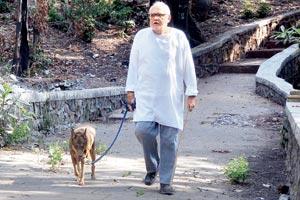
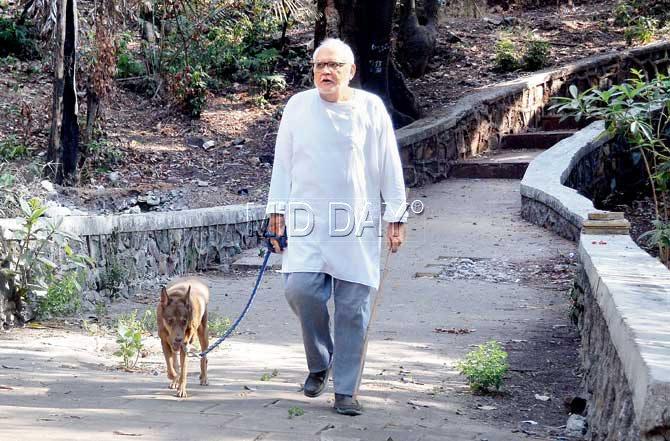
Shrikant Karani takes an early morning walk on the Siri Road steps with his dog Mischief. Pics/Sayed Sameer Abedi
 The peace is palpable, the serenity a shock to the system. I'm on Siri Road, the misty-twisty path languidly climbing from Chowpatty to Kamala Nehru Park. Obscure and often missed in a blink by those not knowing it, this thin lane links Walkeshwar to Ridge Road. Every runner's dream, every walker's mini Mahableshwar in Mumbai, the country road you can drive on only till a point is summer-pretty. Heavy with fresh yellow and red flowers, its glowing greens slope up and up to an idyllic city panorama.
The peace is palpable, the serenity a shock to the system. I'm on Siri Road, the misty-twisty path languidly climbing from Chowpatty to Kamala Nehru Park. Obscure and often missed in a blink by those not knowing it, this thin lane links Walkeshwar to Ridge Road. Every runner's dream, every walker's mini Mahableshwar in Mumbai, the country road you can drive on only till a point is summer-pretty. Heavy with fresh yellow and red flowers, its glowing greens slope up and up to an idyllic city panorama.
This is among the last havens of virgin verdure, affording spectacular sky and sea views at various heights Malabar Hill has hewn since the time it was fully forested. "Around 1534, Siri Road led from Gamdevi village up jungle-covered slopes of Malabar Hill through babul plantations to the banyan-girt temple of Walkeshwar," writes Pheroza Godrej in Bombay to Mumbai: Changing Perspectives. "The stream of worshippers from the west coast followed this path up the hill and, as it was narrow, called it 'Siri' or 'Ladder'."
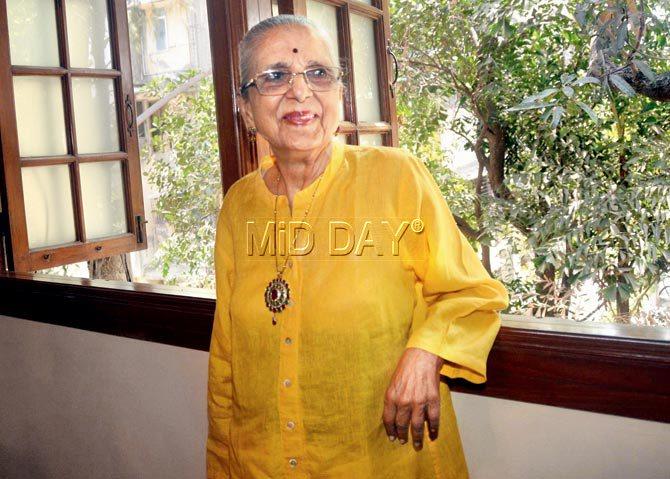
Nonagenarian Nirmala Kotak in the living room of her home at the Dadyseth bungalow, where she has lived for 70 years since her marriage in 1948
I track down Rajkumar Loyalka, after whose father the road is renamed Chiranjilal Loyalka Marg. "My grandfather Ramchandra from Pilani belonged to the East India Cotton Association. His son, my father Chiranjilal, was a stockbroker and freedom fighter," he says.
Siri Road made news three years back when civic authorities wanted to widen and extend its 300 motorable metres by another 300, for traffic to reach Hanging Gardens via Ridge Road. That environmental disaster was averted by vigilant residents mounting a sharp campaign, my friend Kekoo Colah who walks here daily tells me. They painted "Mala kapu naka – Don't axe me" and "Save us from BMC" on the barks of beloved trees. Tipped at both ends by rowed barbers, bus conductors, paanwalas and ragpickers, Siri Road slumbers amid a jumble of shuttered coal and ration shops turned garages and go-downs. But there's trouble in paradise. Sudden bends and secluded niches swerve into kuchcha mud off-paths, whose messily overgrown carpets of dry leaves and dirt piles are hideouts for hardened bootleggers and junkies.

Named for the shape of its fruit
Near enough, city Zoroastrians got the first open-to-sky dakhma, or Tower of Silence, to dispose their dead in 1672. On the sylvan acres of Doongerwadi, prayers for the deceased are liltingly recited in roofed halls called bunglis. The Dadyseth family built one such in the area. The bungli's barest remnants are skirted by Hibiscus bushes with red blooms brighter than the ancient maroon wall ruins they cling to. Banker Dady Nasarwanji amassed vast land tracts in trust to maintain Dadyseth Agiary at Kalbadevi. He acquired the Chowpatty Band Stand property around 1783 from a Portuguese named Barretto.
Nonagenarian Nirmala Kotak has lived from 1948 in the whispering shadows cast by atmospheric Dadyseth bungalow, which is well over a century old. With daughter-in-law Durrat, she pieces memories of 70 years after her marriage. "Our family planted kesar kairi trees in the compound when my three sons were young," she recollects. "We wake to the shrieking of koels and parrots eating mangoes. Peacocks still fly in to drink water from a dripping tap and cobras coil on tree trunks in the heat."
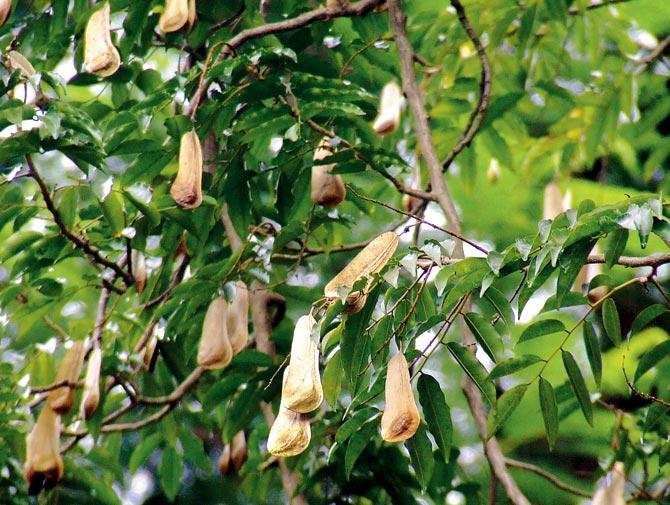
The Stocking Tree grows uniquely on Siri Road alone in Mumbai. Pic courtesy: Shubhada Nikharge
I discover an interesting former Siri Road tenant thanks to Vinayak Talwar of Khaki Tours nudging me to check Volume III of The Gazetteer of Bombay City and Island. The Duke of Wellington indeed lived here when he was Colonel Arthur Wellesley, in a house Seth Cursetjee Manockjee — of the Khada Parsi statue fame — owned, between road and sea at the curve of the bay. (The landlord became such a great friend that his son Manockjee devotedly retained a hair of the Duke in his locket!). The student Eton described as "not at all a book boy and rather dull" went on to vanquish Napoleon at Waterloo and lead England as Prime Minister twice over, in 1828 and again in 1834.
His Bombay home in 1801-02, was "on your right opposite the wood-wharf as you ascend steep Siri road... The house, Surrey Cottage, stood halfway up the now non-existent eastern brow of Malabar Hill. It comprised a lofty hall, with long verandahs at the sides. In front was a porch, to which led two carriage-ways from different directions. One passed the horse stable near the Siri. The hall commanded a view of Back Bay and Girgaum, also the Esplanade and Fort. The Duke, with his eagle eye, must have scanned a glorious scene from Malabar Hill minus steamers and mills."
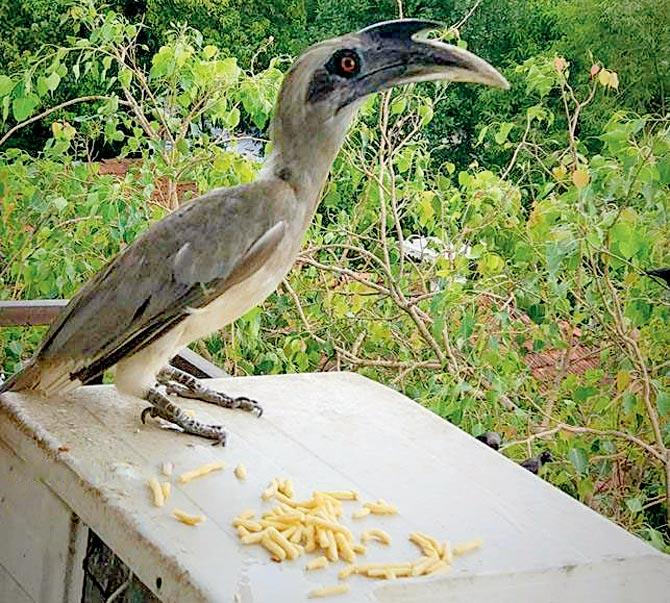
A second generation hornbill hops to the Karani family kitchen window to be fed - at one time two older birds would show up with a pair of their babies, of whom this is one. Pic courtesy: Utpal Tijoriwala
Wellesley had company round the corner in George Bellasis at Randall Lodge. The soldier and amateur artist was the son of Major General John Bellasis, whose 1790s orders constructed Nagpada's kilometre-long Bellasis Road, to relieve the poor displaced from famine-struck Surat. George met his neighbour when the future Duke of Wellington was recouping from an attack of ringworm, more colourfully referred to as the Malabar Itch. While the infection stopped him sail for an Egypt expedition, that ill-fated ship sank in the Gulf of Aden.
George Bellasis admiringly dedicated his 1815 book, Views of St Helena, to His Grace Field-Marshall the Duke of Wellington who exiled the French emperor to that island. A watercolour of Randall Lodge paints a two-storey structure with a rectangular lawn edged by cypresses.
What other breeze-kissed trees rustle secrets along this sequestered stretch? Colonial chronicles mention sandalwood, mistletoe, star apple, ivy fig and Christmas trees, with rose bushes, celery and cabbage patches around Surrey Cottage. Usha Desai and Renee Vyas, of Tree Appreciation Walks, detail a wealth of local flora: banyan, frangipani, asopalav, sitaphal, parijat, coconut, mango, jungli badam, putranjiva, jackfruit and aritha.
Flowering in the rain and fruiting in winter, the Stocking Tree is unique to Siri Road, according to Sharadini Dahanukar's book, Green Solace. "We haven't seen it elsewhere in the city," says Desai. "When we saw this one December, its stocking-shaped fruits had fallen. From a seed sprouted in the stocking, Renee grew a sapling on her farm." The originally South American tree leans against a chawl wall here.
"Trees like neem, peepul and kamrak were believed holy for harbouring the souls of rishis like Valmiki," says Rajesh Joshi, introduced to me by Ridge Road resident Jaidev Mehta who has walked the length of Siri Road thrice a day for 60 years. Rajesh's grandfather Hansraj Sawairam, from Sirohi in Rajasthan, heralded a line of four generations of Joshis tending the "swayambhu" — Sanskrit for "self-manifested" — Hanuman temple. It is supposed to have spontaneously risen on soil imprinted sacred by Ram, Sita and Lakshman in the Banganga vicinity. "Ram chose this quiet spot to meditate because of its solitude," Joshi says.
This is temple turf, proffering a trio of 150-year-old examples. Of these, two survive — Hanuman and Shiva mandir, nestled close-necked towards the top of the road. Descending nearer Walkeshwar, devotees thronged, too, to the Ram mandir from the 1880s, till at least a hundred years after. Motor sports entrepreneur Shrikant Karani and his wife Feruza recollect its beautiful idols left abandoned. We tiptoe through filthy, forgotten tracks in thickets below their building, Chitrakut, which faces the Ram temple site (Sita awaited Ram's return from Lanka in Chitrakut). Birdsong spikes the soporific afternoon air. Shrikant remembers dozens of Parsi Dairy bhaiyyas form inky blue clusters in trademark uniform shirts, Siri Road being their shortcut for deliveries from Walkeshwar to Ridge Road.
A tilt across, where Loyalka Estate later rose, was the home of the seven talented Pooviah sisters from Coorg. Their portico, sunken eight or nine feet beneath road height, was designed as an oasis of cool, not letting warm winds waft within on the hottest day. The three youngest sisters, Sita, Chitra and Lata, were renowned Kathak exponents. Sita also worked at Handloom House in the 1960s with Kamaladevi Chattopadhyay.
Their contemporary, Shirin Vajifdar narrates how she and her classical dancer sisters Khurshid and Roshan bonded with the Pooviahs. In a journal her family shares, Shirin has written: "We started weekly lessons at the Pooviah sisters' house. The three charming sisters were the greatest devotees of Kathak dance, the most promising pupils of Jaipur gharana maestro Sunder Prasad. They gave all help to learn at their residence."
The Pooviahs possessed the sole telephone on the road. "They would offer me biscuits when I went across as a boy to make calls," says Shrikant Karani. "I played Chor Police with kids of maalis who clipped the Hanging Gardens' hedges. We knocked dangling drumsticks with catapults, and shook pink and white champas to string garlands from fallen petals."
Old-timers mention a stone Vishnu once reclined under a gulmohur grove in the wilderness (Anantashayana — literally, "sleeping on the serpent Ananta"). Wondering where the divine Preserver must have basked benignly in the crisp sunshine, I pass Gagangiri Maharaj Ashram. A hum of discourses and yoga sessions mesh mellifluous with birds rapping tender-to-throaty tango tunes. Which could these be from Siri Road's trio of feathered regulars — oriole, barbet or hornbill — I try to guess, twigs snap-snapping underfoot every minute.
"We have a hill station in our backyard," declares filmmaker Vivek Kumar, treading this path as part of his exercise workout. "A little landscaping might even make this Bombay's answer to Crookedest Street of San Francisco."
Author-publisher Meher Marfatia writes monthly on everything that makes her love Mumbai and adore Bombay. You can reach her at mehermarfatia@gmail.com
Catch up on all the latest Crime, National, International and Hatke news here. Also download the new mid-day Android and iOS apps to get latest updates
 Subscribe today by clicking the link and stay updated with the latest news!" Click here!
Subscribe today by clicking the link and stay updated with the latest news!" Click here!









